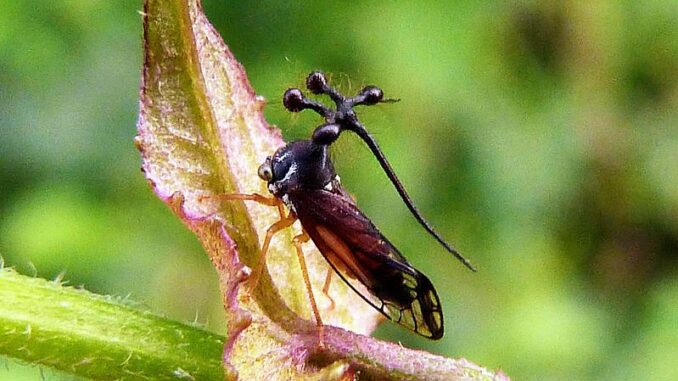
Future expeditions to exoplanets where signs of life have already been detected remotely will need to be prepared to encounter alien creatures because… well, because it’s an alien planet. Preparation for such a meeting can be made by studying the copious strange forms of life on Earth that might just as easily look at home on another world. Probably those future explorers will want to study the ugliest and most revolting creatures Earth has to offer. (It’s unreasonable to expect to find cute, furry, cuddly, and intelligent creatures on every planet we visit.)
When it comes to ugly and revolting, no other group can compete for the title like insects. Sure, there are exceptions like butterflies and bees, but the beautiful ones are far outnumbered by their less well-known cousins, such as Bocydium globulare, commonly known as the Brazilian treehopper. As seen in the picture above, B. globulare has some kind of spacey antenna headgear fashion statement reminiscent of 1950s Atomic Age design, vaguely similar to a model of an atom with orbiting electrons. It could also double as an automobile hood ornament from the same era. While the purpose of this weird crown isn’t known, there are several theories. The leading hypotheses have to do with dissuading predators. It could be a decoy that takes the brunt of an attack, or it might resemble a parasitic fungus growing out of the treehopper’s head that predators find distinctly revolting, not too mention unappetizing.
Scientific Classification
Kingdom: Animalia
Phylum: Arthropoda
Class: Insecta
Order: Hemiptera
Family: Membracidae
Genus: Bocydium
Species: B. globulare
[Binomial name: Bocydium globulare (Fabricius, 1803)]
Brazilian treehoppers are members of the Membracidae (treehopper) family, of which there are around 3,200 known species that inhabit every continent except Antarctica. They are related to cicadas, and bear a certain likeness save the fact that cicadas wouldn’t be caught dead wearing a hat that distasteful. Not all treehopper species sport an appendage on their head like B. globulare does, and those that do look different than the Brazilian’s design. One thing (uh, no… make that two things) all treehoppers have in common is their feeding apparatus. Two tubes extend from their mouths, one of which is used to suck tree sap out of leaves, the other is used to inject saliva into the hole in the leaf: kind of like a mosquito, except the treehopper’s saliva is meant to keep the hole open, whereas a mosquito’s saliva is meant to close the hole (because those bloodsuckers are considerate).
Also like mosquitoes, treehoppers can carry disease from tree to tree. This is one reason customs inspectors examine cargo imported from other countries so very carefully. If treehoppers are found, the cargo is impounded until the authorities decide whether to destroy it or send it back to the country of origin.
Will interplanetary explorers be greeted by creatures as hideous and destructive, yet still as fascinating as B. globulare? Probably, and some even moreso. Ask an exobiologist who knows.
Question Of The Night: Speaking of leaves, what’s the best thing about Autumn?
